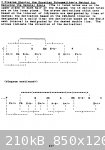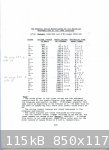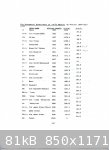David.B
Oud Junkie
    
Posts: 640
Registered: 9-5-2009
Location: France
Member Is Offline
Mood: Renaissance
|
|
"Arab Music Theory in the Modern Period"
By Marcus, Scott Lloyd.
As I'm reading it once more I propose to share my own annotations (in red).
This is because I respect and use a lot this work that I intend to make some remarks (right or wrong, it's up to you), where it remains obscure to me
...
p43
[...]Mustafa III [ruler of the Ottoman Empire, 1757-1774][...]
p98
The diagram
...B-b- | | c
..........B |
...........|-|
.............^
.............^
..............t
|
|
|
David.B
Oud Junkie
    
Posts: 640
Registered: 9-5-2009
Location: France
Member Is Offline
Mood: Renaissance
|
|
p113
"Surprisingly, though, this four-octave spread is not viewed as a challenge to the concept of a two-octave ambitus. Rather each instrument is thought
to manifest the same two octaves, each in its own range. Thus when the various instruments play a given note, say Rast, the resulting sound is a note
reproduced over four different octave, yet it is still tought that each instrument is playing the note"Rast" (see chart below). The nay's pitch, an
octave above the violin's, is not thought to be jawab Kirdan and contrabass are not thought to be playing Rast and
qarar Rast, respectively. When the note, Kirdan, is called for, then all the instruments will shift to their
respective higher octaves."
If we follow the "chart below" on p115
|
|
|
David.B
Oud Junkie
    
Posts: 640
Registered: 9-5-2009
Location: France
Member Is Offline
Mood: Renaissance
|
|
p824 (appendix 5)
2 errors on the photo below:
Dokah - 0.2
Awj + 0.8

|
|
|
David.B
Oud Junkie
    
Posts: 640
Registered: 9-5-2009
Location: France
Member Is Offline
Mood: Renaissance
|
|
p821 (appendix 5)
I used table p821, diagram p827 and the text below to correct the table p826:
"After establishing the fundamental scale, the subcommittee then set about to define the remaining 17 notes in the general scale. A quick glance at
the resulting scale (see table below) reveals that most of the 17 additional notes differ significantly from their equal-tempered counterparts: 11 of
the 17 are "off" by between 7.4 and 10.7 cents (this is not the case anymore with the correction on table p826). On
closer examination, however, this is not the total forsaking of the equal-tempered system as it first seems. As noted in the Congress quote above,
some of the remaining notes were measured in aural tests while others were derived mathematically as their intervals were "unanimously affirmed [to
be] equal to those intervals already measured" (Recueil 1934:595). The additional rested notes, four in number, were found to differ substantially
from their equal-tempered equivalents (see below). When these four notes were used to derive other notes, then their deviations from equal temperament
were passed on to other notes, even though the intervals which were used to derive the other notes were themselves often tempered (see summary diagram
below). For example, Eb was given a value of 292.6 cents, 7.4 cents below the equal tempered position (closely approximating the Pythagorean minor
third of 294.1 cents). From this Eb, the note Db was derived following the assumption that the interval Eb to D was the same as the interval Db to C
(ibid.:601). As D and C were determined to be at a near-tempered interval of 199.8 cents, Db and Eb were now separated by the same interval. Thus,
though derived, in part, from this near-tempered interval, the Db came to have the same position relative to equal temperament that the Eb had: Db was
given the value of 92.8 cents, 7.2 cents below the equal-tempered position (nearly identical with the Pythagorean
minor second of 90.2 cents).
The Eb's deviation from equal temperament, having been passed on to the Db, was then passed on to four other pitches in similar fashion: D=/= was
derived from the Db by the following reasoning: "the interval between [D=/=] and [Db] [three quarter-steps] equals the interval between [D] and
[E-b-]" (ibid.:601). Here again, we have a near tempered interval (D to E-b- was defined as 149.1 cents) applied to a
non-tempered starting point (92.8) resulting in another non-tempered note (D=/= came to be 241.9 cents. E natural was then derived from the D=/=, and
finally F=/= was derived from the E as both these intervals (D=/= to E and E to F=/=), it was agreed, were equal to the same D to E-b- interval of
149.1 cents: E came to be 391 cents [1] ; F=/= came to be 540.1 cents. Going back to
the original Eb, E=/= was then derived by the application of the same 149.1 cent interval (E=/= came to be 441.7 cents.
In this way, all the derived notes were arrived at by the application of near-tempered intervals to one or another of the 11 (7 + 4) tuned notes. If
the near-tempered interval was added to one of the seven Tas notes, then a near-tempered note resulted (as with C=/=, D-b-, G-b-, and A-b-). When the
tempered interval was added to one of the four non-tempered notes, then the result was an additional non-tempered note.
Besides Eb, the other three tested notes were Bb, Ab, and B. [2] Bb was given the value of 1009.9, 9.9 cents above the equal-tempered position
(between the Pythagorean 996.1 and the just 1017.6): this deviation was passed on to B=/= by the application of the same D to E-b- interval of
149.1. Ab was given the value of 797.1 cents, 2.9 cents below the equal-tempered position: this deviation was passed
on to A=/= by application of the same 149.1 cent interval. B was given the value of 1092.4, 7.6 cents below the equal-tempered position: this deviation was passed on to F# by transposing it down a near-tempered fourth of 502.3
cents.
Closer analysis this reveals that although many notes of the Egyptian subcommittee's general scale deviate from the equal-tempered positions, there is
an underlining coherency which is provided by near equal-tempered intervals: 11 of the 13 derived notes were arrived at by transposition of the D to
E-b- interval of 149.1 cents; the other two (Db and F#) were derived by the application of intervals of 199.8 and 502.3 cents, respectively (see diagram below)."
I tried to understand the table p826 as it has been written but without any success, if you can, please tell how.
p827 (appendix 5, above the diagram)
"A Diagram Showing the Egyptian Subcommittee's Method for Deriving the General Scale (The 11 tuned notes are on the upper plane in each half of
the diagram; the 13 derived notes are on the lower plane. The eleven derivations which were based on the interval of 149.1 cents are designated by lines of dashed; the derivation based on the 199.8 cent interval is
designated by a solid line; the derivation based on the 502.3 cent interval is designated by the dashed double line. The arrows indicate the direction
of the derivation:"



|
|
|
David.B
Oud Junkie
    
Posts: 640
Registered: 9-5-2009
Location: France
Member Is Offline
Mood: Renaissance
|
|
p830 (appendix 6)
"Note that this scale does not include the seven half-sharp notes, C=/=, D=/=, E=/=, F=/=, G=/=, A=/=, and B=/=."
|
|
|
David.B
Oud Junkie
    
Posts: 640
Registered: 9-5-2009
Location: France
Member Is Offline
Mood: Renaissance
|
|
p187
I can't check out c.v.p. so I corrected c.v.i. which I guess had been calculated from c.v.p.

|
|
|
David.B
Oud Junkie
    
Posts: 640
Registered: 9-5-2009
Location: France
Member Is Offline
Mood: Renaissance
|
|
p207
"The need for two Ab's is expressed in a number of theoretical works including the Egyptian subcommittee's report in the 1932 Congress publication
(ibid.) [26], al-Shawwa (1946:13), and al-Sabbagh (1950:173)."
|
|
|
David.B
Oud Junkie
    
Posts: 640
Registered: 9-5-2009
Location: France
Member Is Offline
Mood: Renaissance
|
|
p251/252 (note 34)
"Besides the Hijaz tetrachord and the Nawa Athar/Nakriz pentachord, D'Erlanger also mentions three other tetrachords which include an augmented-second
interval in his description of modern practice (1949:88ff.): Awj Ara with intervals of 3/4, 6/4, 1/4 or 3/4, 6/4, 2/4 (but I
can't find the last interval, 2/4. What I found is a strange B-b- c d# eb ! This interval is impossible in practice, in my opinion... I used this pdf
to compare: http://www.rembetika.com/La_Musique_Arabe.pdf); Sipahr with intervals of 6/4, 2/4, 2/4 + 4/4; and Sazkar with 6/4, 1/4, 3/4 + 4/4."
|
|
|
David.B
Oud Junkie
    
Posts: 640
Registered: 9-5-2009
Location: France
Member Is Offline
Mood: Renaissance
|
|
p220
"Pythagorean
294.3"
In cents for Eb.
The way I calculate:
If a comma is about 22,642 cents (1200/53, the fifty-three tone equally tempered scale) and C Eb is 13 commas,
22,642 x 13 = 294,3 cents
This is the way al-Sabbagh calculates p252, note 36.
If you know the method to find 294,1 cents, please tell me.
p220
"The Eb is raised 13,4 cents while the Ab is raised 11,1 cents, i.e., about half the size of a Pythagorean comma."
|
|
|
|